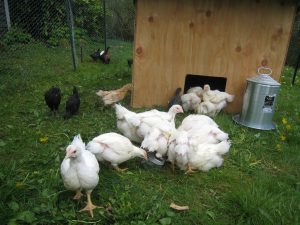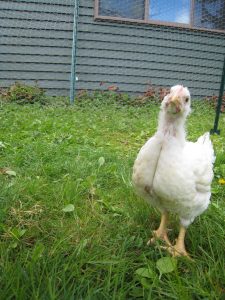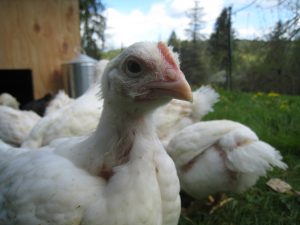As I explained in my last post, last December, I decided to raise my own birds for meat. Having helped another family slaughter sixty chickens, when I was age 6 or 7, I was complacently comfortable with the idea. In the dark of winter, I didn’t figure out all the details. I’m prone to grandiose hand-waving accompanied by “It’ll be fine†or “We’ll figure it out, later.†The minutia that matters had been left as an exercise for the spring (with me as the “idea guy,†my ex frequently got stuck with some of these details to “figure outâ€). In mid-February, she asked a question so simple it belies its complexity. “How many and what breed?†She was ordering our egg chicks from a mega-hatchery in the mid-west and needed to place the order. I still hadn’t done any research or prep work, knowing I’d figure it out when I needed to (insert hand waving here)… well, I needed to.
I spent a couple of hours digging into Wikipedia articles and documentation on breeds typically raised for meat and concluded that I’d go with the “most common, failsafe, typical†breed. Jumbo Cornish Cross is a breed that originated in the 30’s, selectively bred for large breasts and the speed of growth. When you buy chicken at the grocery store or in a restaurant, this is almost unvaryingly the breed you’re getting. I brushed aside a couple of alarmist comments on www.forums.so-you-wanna-raise-
- $1.25/chick
- quantity 14 (“I dunno, whatta you think? How ‘bout a dozen?â€)
- add to cart
- checkout
- done (hand waving away the rest of the important details, “we’ve got monthsâ€)
5AM, our phone rings. We missed this call, but it woke us up enough to check our voicemail. The message said, “Your chickens are here. Please come pick them up.†Our post office is a small, single counter, rural post office and when I arrived, 20 minutes later, I could hear a cacophony of tiny baby bird cheeps from the lobby. After I rang the will-call bell, the top-half of the Dutch door opened to reveal two full-sized tables covered in little boxes of chicks; a heat lamp was somewhat precariously hung over each table. CHEEPCHEEPCHEEPCHEEP, the largest hatchery in the US only has a few delivery dates and our delivery was clearly only one of dozens in our part of rural Washington State, today. The Duvall post office clearly knows the drill and prepared appropriately. Our tiny box emitted a solid CHEEPCHEEPCHEEPCHEEP on the drive home and it continued as they were transferred into the makeshift brooder box fashioned out of Home Depot scrap lumber, last year (less than $7, including casters.)
They seemed innocent enough. They were exactly the same size as this spring’s “egg bird†chickens and their demeanor almost identical. They were adorable, as all baby chicks are. They were fluffy, white, and almost completely helpless. All the chicks pooled under the heat lamp and did their best “melting†routine. As they fall asleep, they allow all their tiny muscles to relax and as their little bodies slowly settle into the pine shavings, they leave the impression that they’re melting. “These aren’t freak of nature chicks. They’re just chicks.â€
A few days later, it was clear that these birds were bred for meat. They packed on the pounds at an alarming rate. Clearly larger than the layer chicks, I was concerned about the equitable distribution of food and introduced a divider down the center of the box to separate them from the layer chicks. At two weeks, the Cornish Cross chicks were nearly twice the size of the breeds we’d purchased as layers. In addition to the “meat birdsâ€, we had ordered some layer hen chicks to replace those eaten by predators, last year: Black Sex-Links, Arucanas, Barred Rocks, and were surprised with a Brahma or Cochin “Free Chick†rooster (“buy 25, get a free rare birdâ€). This year and last, I’d admired how the Sex-Links always aggressively pursued food. They seemed to have great survival instincts and were bold, outgoing, and curious… but they were amateurs compared with the Crosses. These girls wanted their meal and wanted it NOW! We took to calling the left-half of the box the “Fatty Chickens†or “The Fatties.†When we talked about them, my ex often referred to them as “your chickens,†reminding me that this motley bunch was my idea. Her not-so-subtle slips of language took the form of comments like, “Have you fed your chickens yet?†or “Man, your chickens are nasty.â€
Each trip to the garage, just hours apart, I’d find that The Fatties had completely emptied their food. On the other side of the box, an equal number of “egg birds†(which we’d started calling, the “Little Girlsâ€) had barely touched theirs. I augmented with a second feeder. They emptied both. Having read a lot more about this breed, I started regulating food. The most scathing commentary about the bird highlights that, given free access to food, their bodies grow out of proportion and their legs can’t support their rapidly growing bodies. I found some missives that described several families’ experiences. Most of them still seemed to think that it was acceptable to raise this breed, with a few caveats… including the rate that they’re allowed to consume feed.
At 4 weeks, they’d outgrown their half of the brooder box and were transferred outside. Some perspective is due here. All 25 chicks were shipped in a small vented cardboard box roughly 10 inches square and about 3 inches tall (remember that these hatched from eggs). It was a cozy fit, but they could still move around (they won’t ship fewer than 25, as they need to have contact with other chicks for warmth). Less than a month later, 14 of these chicks had outgrown their 4 foot by 3 foot section of the box. They’d grown from the point where I could hold 3 or 4 of them in one hand to each of them roughly the size and shape of a small cantaloupe, roughly the size of our one year old laying hens. Size wasn’t the only indicator that the Fatties had ‘turbo instructions’ in their genetic programing. They were fully feathered. The Little Girls more closely resembled a can of soda and had just started putting on feathers, giving them a loveable awkward gangly teenager look.

With the weather warming up, we assembled a roosting house out of 3/8ths inch plywood, tacked some poultry netting to t-posts and relocated The Fatties to their own front yard pasture. They adapted quickly and the Little Girls were happy to have the full brooder box to themselves. I continued to regulate The Fatties’ food and they took to foraging better than I expected. They’d occasionally find some unfortunate worms, slugs, bugs, or grubs. They scratched the lawn in their makeshift pasture and picked at the more tender grass. Chickens acting like chickens. All I could have hoped for.

I was, however, shocked at how quickly they grew. Their legs had grown in a wide stance like a linebacker with huge pectoral muscles filling everything between. The fat squat little birds waddled and flapped their wings when they ran. I’d never thought of a chicken as graceful, but started to regard our full-grown laying hens as ballerinas by contrast. We often joked that they looked like they had really bad boob jobs, as the size and angle of their breasts looked… well… fake.
By 5 weeks, The Fatties were the size and weight of a 5-lbs. bag of sugar. They were lazy and awkward. They largely sat alternately in the shade, and the sun, then back again. The foraging instinct had given way to the chicken equivalent of couch-potato-channel-surfing-
At 6 weeks, we moved the Little Girls out of the brooder box and into the fenced front-yard pasture with The Fatties. After a few turf wars and establishing pecking order (Fatties first, as they were over twice the size of the Little Girls), they settled in. We moved the roosting house every day or two and the entire fenced area was moved every week or so. The Fatties sat with no regard for hygiene, often not moving when they pooped, resulting in crusty chicken shit on their feathers. I hadn’t exactly thought about our laying hens as “clean,†but when presented with these foul eating-pooping-sitting-

At 7 weeks, in a poorly planned and poorly executed attempt to weigh them, I drew the conclusion that the one I plucked out of the pen was “at least 7 pounds.†By this point, we were trying to decide which weekend to slaughter them. They didn’t seem unhappy, but we felt wrong about letting them continue. We were into the peak of summer and it was evident that the heat was too much for them. They sat on their huge chests, with one leg cocked out to the side and their wings hoisted off their bodies in an attempt to stay cool. The Little Girls were fine and actually seemed to enjoy the sun. We setup a misting system to provide some evaporative cooling for The Fatties, it seemed to help, but just highlighted that these are not “natural chickens†(natural = “of nature†and we had to give these birds A/C). The weather cooled for the next couple weeks, while they continued to eat and grow.
It was clear that these birds were going to be better off in our freezer than in our yard.
In the next post(s), I’ll share our second experience slaughtering chickens.